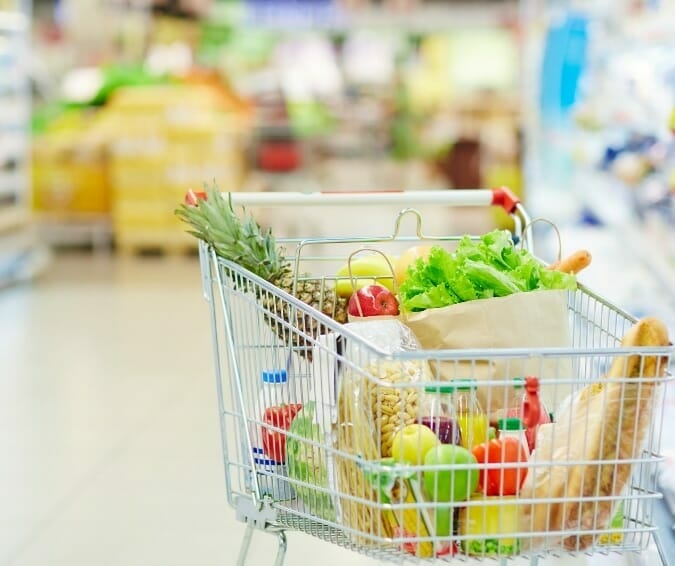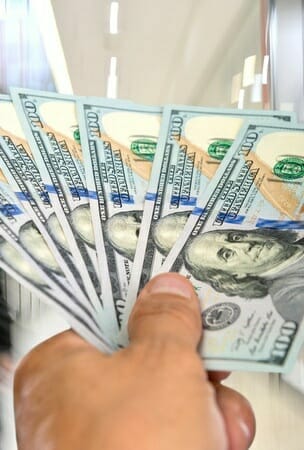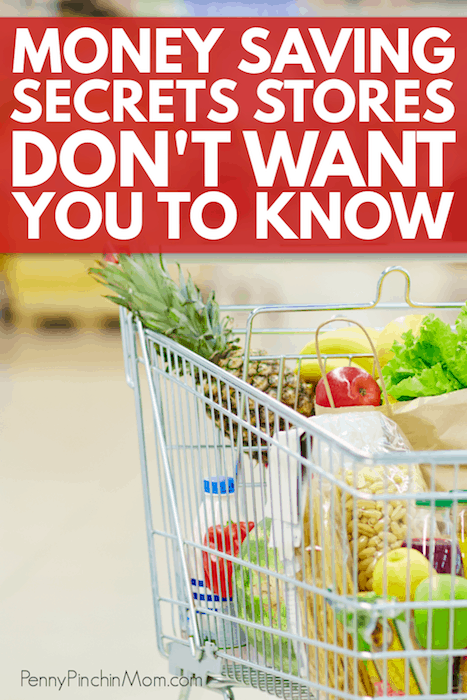Supermarkets and retailer stores know consumers. They have spent countless time and resources researching to understand how you shop. They use this data to get you to buy more! Lucky for you, I’ve figured out these store secrets and am sharing them with you!

Grocery stores and big-box retailers will not be happy that you’ve learned these secrets. But, before you walk mindlessly through the aisles, tossing items into your cart, make sure you aren’t falling for any of these grocery store traps!
STORE SECRETS YOU NEED TO KNOW
1. PURCHASE LIMITS
Many retailers will place limits on products. Many times, these products are not on sale, they just add limit wording to the signage. When people see this, they think that they are putting a limit on the purchase because it must be a hot product. If this is a hot product, then I should buy it so that I don’t miss out!
Money saving tip: Only purchase the items you have on your list. You should also check the original price of the product before you buy to make sure that it is on sale and a good deal and not just another marketing scheme to get you to spend money.
2. SHOP THE UPPER AND LOWER SHELVES
The most expensive products are at eye level.Most people are in a hurry and will purchase what is right in front of them. If you look up and down, you can find store brands and other brands, which are less expensive.
Money saving tip: Scan up and down all shelving to ensure you are getting the best price.
3. TWO-FOR AND BOGO DEALS
These often seem like a good deal, and they can be. When retailers say that you can get something for free, you may purchase an item you initially did not plan on buying. You might also buy additional things that you did not need, just in an attempt to save money. There are times when these offers can save you money, but most of the time, they are an attempt just to get you to buy more.
Money saving tip: Know the store’s regular prices. You can find the item on the shelf and look beneath the sales sticker to see the original price. You can then determine if the sale is a good one or not. It is usually not a good idea to buy more of something you did not need, just to save a buck.
4. CHECK THE SIZE
If you are looking for items in your grocery store or even towels at your favorite department store, you need to check the size and price. For example, you may see ketchup on sale 64 oz for $3.25, which appears to be a good deal. Take a look at this per unit. At this price, you are paying $0.051 per ounce.
If you look at the 40 oz bottle priced at $1.99, you will see you are paying $0.0498 per ounce. There is not too much difference per ounce here, but it all adds up and you get more for your money if you purchase a 40 oz bottle instead.
Money saving tip: Know the prices in the other stores for your favorite items. Compare sizes and quantity before you buy to ensure you are getting the best possible deal.
5. DON’T FALL FOR THE DISPLAY
Some stores hire experts to create magical displays. Sometimes, it is so unique or artful that it makes you feel you need to have the product they are selling. They may even add in images of good-looking men, women, and children wearing them. When people see these images, they think that they too will be happy and look good if they buy the item.
Money saving tip: Things won’t make you happy. Spending too much money on things will make you broke – which will make you more unhappy.
6. AVOID THE END CAPS
Just because an item is on display at the end of an aisle does not mean that it is a good deal. Sometimes stores will merely relocate items inside the store to try to capture the buyer’s eye. When people see things on display, they tend to assume it is on sale. Sometimes it is, but there are times when it is not.
Money saving tip: When you see something on an end of aisle (end-cap) display, take a moment to find it’s original location in the store and check the regular price. Sometimes it is not on sale at all.
7. VEER LEFT – NOT RIGHT
Most Americans are right handed. As a result, they tend to go to the right side of the store when they enter. Retailers place additional displays here to lure you into spending more.
Money saving tip: Turn on your blinders and avoid falling into these traps by sticking to the items on your list.
8. CASH ONLY
How many times do you see these displays where you can save 15% of you open a charge account? Even if you don’t open a new account, if you use plastic, you tend to spend more. Reatilers like it when you use plastic as you often spend more.
They also know that most people will not pay off the balance right away, which will allow interest to accrue, which in turn makes them money.
Money saving tip: Never sign up for any store offers just to save money — unless you can ensure you will be able to pay it off right away. In fact, if you sign up, you should be able to turn around immediately and pay off the balance on the card without having to wait for the statement to arrive. When you shop, stick with cash because you can see how much you have to spend right there and can’t overspend.
9. CLEARANCE TAKES TIME
How often do you notice that the clearance section in the back of a store is an absolute disaster? If it is disorganized, most people will pass on shopping.
Money saving tip: If you want to find good deals, make sure you are patient enough to weed through all of the clearance items to find that treasure.
10. AVOID THE ADD-ONS
Those little items, foods, and magazines are the checkout for a reason. You are going to be standing there and will read the covers and think you need to buy. Or, you will look around at things and tend to pick them up. Or, if you are waiting for a while, you might be hungry and be tempted to grab a last minute snack.
Money saving tip: Just leave those items alone and do not add them to your shopping cart. It may take some self-control, but those little purchases can quickly add up.
11. SING-ALONG
How often do you find yourself wandering the aisles singing along to the music playing overhead? There is a reason for that. Easy listening tunes you enjoy make you want to spend more time and get relaxed, which can lead to more spending!
Money saving tip: Put your earbuds in and listen to your own fast-paced tunes or try not to pay attention. If you find yourself dawdling, use a timer so you can get in and out of the store in 20 or 30 minutes.
12. SKIP THE MEAT COUNTER
Consumers want the freshest products and assume what you get at the meat counter is better, but that is not the case. You end up paying a premium for the butcher to package your product for you.
Money saving tip: Don’t buy at the meat counter and check the meat and seafood packaged and ready for purchase. You may even find rare coupon savings stickers attached to them – so keep your eyes open!
13. HIDDEN DAIRY SECTION
Have you ever noticed that the milk and eggs are in the furthest corner in the store? They do this intentionally. Milk and eggs are a staple most people buy. The store hopes that as you work your way back to the dairy department, you’ll fill your cart with other items you don’t need.
Money saving tip: When you walk into the store, walk directly to the dairy department and work your way back towards the front. You’ll often bypass some of the aisles you usually do not walk through and may be less tempted to buy.
14. SHINY PRODUCE
One walk through the produce department and you will notice the misters spraying down the produce. They do this as it looks fresh and shiny and draws you in.
Money saving tip: Dry off the produce before you put it into your bag as you end up paying for water at checkout. Also, too much moisture can make your produce go bad more quickly.
15. SMELLS APLENTY
One walk through the doors and you often smell freshly baked bread filling the air. They pull you in and make you want to buy more as they often instantly make you feel hungry and a need to buy.
Money saving tip: Shop on a full stomach, and you’ll be less tempted by the delicious baked goods.
Now you know the supermarket and retailer traps to avoid the next time you shop. I am sure your wallet will thank you.


